Gazebo Attached to House: Design & Safety Factors
Author: Rick Worst | Editor: Omar Alonso
Review & Research: Jen Worst & Chris Miller
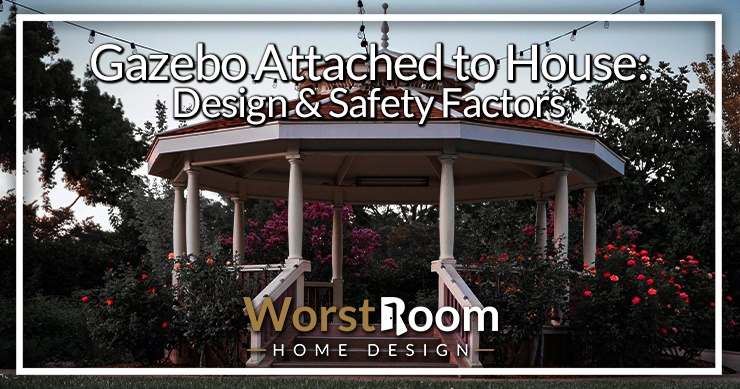
When building a gazebo, homeowners usually have two choices. They can build it as a standalone structure or have the gazebo attached to the house. But there are many safety concerns that one should think of when building an attached gazebo.
Keep reading this article to find out whether it’s safe to build a gazebo attached to a house, how far it should be from the house and your outdoor fireplace, and what factors you should consider before building a gazebo.
We’ll also share a detailed comparison between freestanding gazebos and the ones that are attached to houses so that you can make an informed decision on which one will be the right for you. Let’s dive in.
Is it Safe to Build a Gazebo Attached to a House?
Gazebos are commonly seen as freestanding structures, but it’s completely safe to attach to a house. It can be a nice place to set up a grill, hang out with family and friends, and keep your favorite plants.
Building gazebos attached to houses like a pavilion is now common practice for many homeowners, and there are no safety concerns if you build them right. The roof of a gazebo is often made of metal, and the columns are made of wood or aluminum.
How Far Should a Gazebo be From the House?
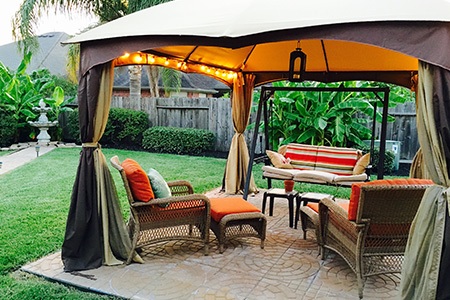
Many homeowners are interested in building a gazebo attached to their houses. Naturally, the question arises of how far the gazebo should be placed from the house or any other structure.
Unfortunately, there’s no simple answer to the question of the proper gazebo distance from the house. How far your gazebo needs to be from your house depends on your area. The local codes are different in every town and country. In many you can gave the gazebo right next to the house or even up against the house, or as we're discussing, connected to the house.
You’d have to check in with your local town hall or planning committee to get the correct answer. But on average, you can expect it to be around at least 3 feet. The idea behind ensuring that you have this minimum distance so that the view from the windows of your neighbors isn’t blocked.
Considerations Before Building a Gazebo Attached to Your House
Gazebos are a nice addition to your house to hang out with your friends or enjoy your favorite book by yourself. But there are some considerations that you must keep in mind before deciding to build a gazebo attached to your house.
Lighting Conditions
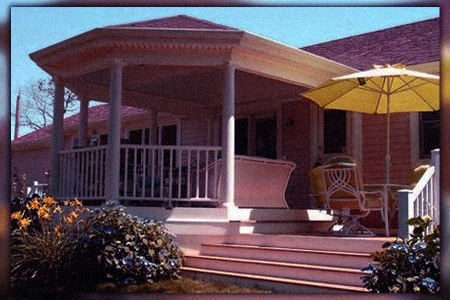
The ideal location for a gazebo should have a good mix of sunlight and shade. Putting it in an area where it receives the full sun will be too hot and uncomfortable. But sunlight is also essential for a good outdoor space like a gazebo, and you can’t completely discard it.
If it’s in full shade the whole time, then it’ll be too dark, and you won’t be able to fully enjoy it. While the right lighting conditions for a gazebo vary depending on the owner, it’s good to put it in a location that has at least six hours of sunlight and four hours of shade.
Fire Safety Considerations
When choosing the ideal location for a gazebo, you must consider the fire safety requirements of your area. You may need to install a fire extinguisher or fire sprinklers if the gazebo exceeds a certain number of square feet.
If it’s close to a deck or shed where you could find combustible materials, you may need to install a fire break. All these requirements are different depending on where you live. Check with your local building authority to know what the exact requirements are for your locality.
It’s a good idea to keep the gazebo away from an area where trees or other large structures could fall on it and start a fire. Build it in a location that’s easy to access for emergency vehicles so that first responders can put out a fire if such an accident ever occurs.
Wind Protection
Gazebos are great as they can be used to provide shade in the summer and keep you warm during the winter months. But you want to build it in such a way that it complements your house instead of creating problems for it.
It’s not a good idea to place a gazebo where there’s a direct breeze. The elements in the gazebo can go around if there are strong winds and damage your house.
Accessibility to Water
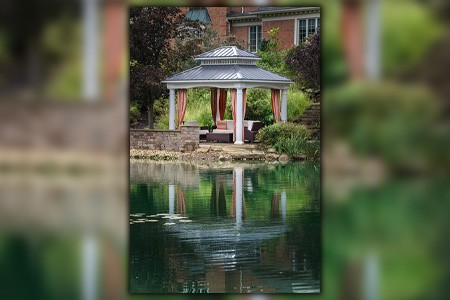
Building a gazebo offers homeowners an opportunity to be creative with their landscapes but having visible water be close by is one of the most enjoyable aspects of a gazebo that they must consider. Whether that's a pond, lake, river, or a creek, simply being near water is relaxing.
Do a thorough inspection of your property and find out the locations of the water sources before you choose where you want to build the gazebo. Build it close to any of these water sources.
Gazebo Attached to Your House vs. Freestanding
Choosing between an attached and detached gazebo can be a tough choice for many homeowners. The cost to make each of these gazebos is similar, and that makes the decision even harder.
The right choice for you depends on your personal preferences. But here are some factors you should consider before choosing whether you should go for a freestanding gazebo or one that is attached to the house:
Protection from Weather
You can move easily from your interior to the porch or patio without any fear of being exposed to rain or snow if you have a gazebo attached to your home. It’ll cover the sidewalls of your house and protect them from UV damage and other harsh weather conditions, which is more than even a screened-in pergola can say.
With a freestanding gazebo, you don’t get the same protection against harsh weather. As it’ll be placed at a distance from your home, you’ll be exposed to rain or snow when going to it. The gazebo itself will also be more vulnerable to bad weather as it’ll be open on all four sides.
Quality of Construction
Gazebos that are attached to a home or an outdoor building share the structure on which the house is built, and that’s why they’re stronger than the freestanding ones. You’d often need permission to build an attached gazebo. Check your local county or city website for information like this related to possible gazebo building permits.
The final expense of building a gazebo up against a house will be the same as a detached gazebo, as needing fewer posts to build it will offset the cost of getting the permit. Freestanding gazebos don’t normally need any permits, and you can save yourself the trouble of going through administrative offices if you build them.
But you’ll be spending a lot in additional material and labor costs to make concrete posts that are capable of managing the load and lift to ensure that you have a strong gazebo installation. Just like any pergola footing, you'll want to make sure you also anchor them down. It's non-negotiable.
Design Flexibility
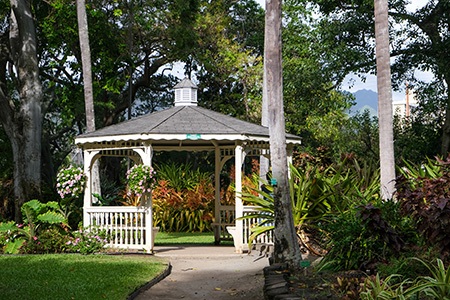
While setting up an attached gazebo is much easier than a detached one, you’ll be much more limited with the attached gazebo in terms of design variations. There are many more design options for freestanding gazebos, as you won’t have to line up the gazebo elements with the structure of your house, such as worrying about how many feet are in the first story and matching that for a cohesive look.
Not only is a detached gazebo more flexible in the design structure, but you can also design them any way you want with custom gazebo end cuts, faux food wrap, faux columns, and many other options.
Consider the height of the gazebo, attached or not, in the exact same fashion you'd consider the height of a pergola. You it shouldn't exceed the height of other structures around it, but should match similar heights. You'll want to consider what you'll be doing underneath the gazebo as well as any fixtures you may want to install such as lights and fans.
Ease of Using Accessories
If you intend the gazebo against your house to be something you use on a regular basis, setting up the accessories in it easily will be an important consideration for you. You can easily add accessories like retractable motorized screens and curtains in attached gazebos compared to detached ones as they only need protection from three sides.
You can also add other important accessories like heaters and outdoor TV types more easily to an gazebo connected to a house as you can easily run electricity to it. However, it’s more challenging to incorporate these accessories into a detached gazebo.
Since they’re also open on all four sides, that means the motorized screens and curtains will be harder to use. You’d need to adjust them more frequently to move in and out of the space.
How Far Should You Place a Gazebo From a Fireplace?
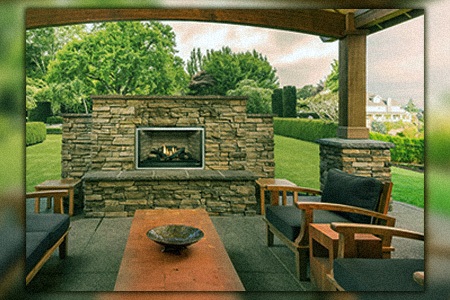
Having a fireplace and being warm and cozy in the gazebo next to your house is a nice feeling, especially in winter. With the right tools, you can create a fire pit and make sure your gazebo stays warm. In that instance, it’s normal to question what should be the distance between a gazebo and any outdoor types of fireplaces.
The answer depends on the size of the fireplace or fire pit. A normally sized fire pit will heat a space of about 3 feet. So, if you want to enjoy the warm fire from your gazebo, you need to place them at least 3 feet apart from each other. This begs the question of how big a fire pit area should be and if the gazebo should be within that space. For safety reasons, the answer is no.
Your main concern is that the flames or heat from a fireplace or fire pit don't reach the posts or roofing of the gazebo and cause a fire. Heat dissipates quickly over distance, but zero chances should be taken. At least a dozen feet for a small fire pit or fireplace is a wise move.
Build Your Gazebo Attached to the House!
Now you know that having a gazebo attached to a house is not only safe, but it’s also a great piece of decor that brings life to your home. Consider the main differences between a freestanding and attached gazebo and choose the one that fits your preferences.
If you decide to build a gazebo attached to your house, make sure you get the necessary permits before starting your construction. Build it safely so that it doesn’t affect the other parts of your home.



